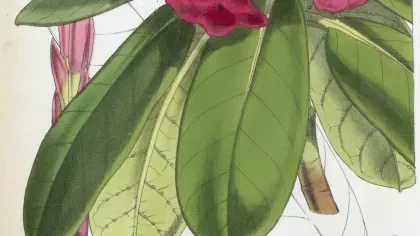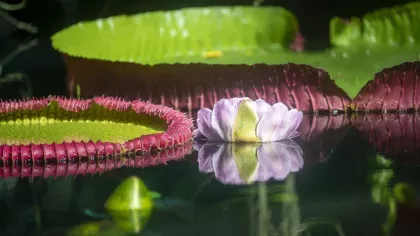5 September 2023
The quest to paint Kew's giant waterlilies
The story behind botanical illustrator Lucy Smith's epic metre wide painting of a Victoria amazonica leaf - on display at Kew until 17 September 2023.

Grown at Kew every summer, Victoria are the largest waterlilies in the world, with leaves reaching over 3m wide.
Drawn from the blog of Kew botanical illustrator Lucy Smith, this is the story of her epic five-year project to create life-size paintings of our giant waterlilies.
You can see Lucy's work and get even closer to these plant goliaths in The wonderful world of water plants at Kew’s Shirley Sherwood Gallery until 17 September 2023.


Botanical art is more than pretty pictures: it’s an important part of studying plants. An illustration that clearly shows all the parts of a plant is worth a thousand words – and, of course, you can learn a lot about a plant from drawing it.
One of my Kew predecessors was prolific botanical artist Walter Hood Fitch, whose Victoria illustrations from 1845 were on display at the Shirley Sherwood Gallery in 2014. He used preserved specimens collected in Bolivia and, later, live material from plants grown at Kew and I could see he was genuinely fascinated.
That was the spark that drew me in. I decided to try and illustrate the different forms of each species’ flowers to help define the species more clearly.


Meeting the Victorias
I was invited to help plant a baby Victoria amazonica in the Princess of Wales Conservatory in April 2019, grown from seed by Kew's resident giant waterlily expert, botanical horticulturist Carlos Magdalena. It was weird trying to plant something into soil underwater. At this stage its leaves were only the size of dinner plates.
It had a wonderful summer producing beautiful blooms, which I drew and painted. At first, my focus was on capturing the flowers. When I was asked, “will you be drawing a life-sized leaf?” I shrugged it off as a joke. Victoria leaves reach around three metres wide; how was there paper large enough, or hours long enough, to take on such a project?
Still, not every Victoria leaf is that large, so I purchased my first ever roll of large sized watercolour paper and propped it in the corner of my studio to think on, for later.
By November, each new leaf produced was smaller than the last as the days became shorter. I decided to give it a try. I chose a leaf that was in good condition and roughly 1m in diameter.
I didn’t know what the underside would look like until it was cut; I was delighted to see its beautiful colour revealed when it was flipped over. I took lots of measurements and photos, before cutting the leaf into pieces to put into a herbarium press.

Locked down
I made a simple but accurate A2 line drawing, scanned it, and put it aside. Then early 2020 arrived. Suddenly, stuck at home, I had the time to start painting.
I figured such a large sheet of paper would need to be stretched on a board. First, I practised stretching and taping down smaller sheets onto which I drew small portions of the leaf, trying out the painting techniques I would use on the real piece.
Stretching the paper for the final piece was a family affair. I was grateful to have a couple more hands to help uncurl and cut the paper. Four handy cans of baked beans helped to hold down the corners while I sprayed and brushed it with two coats of water, helping the fibres to relax and flatten. The scariest part was lifting the damp sheet of paper up and over, onto the waiting board.
The drawing room
Using a projector I had purchased for exactly this task, I set the paper up in a room of the house which could be darkened, and which was just long enough to position the projector far away enough for the board to show it at the correct size.
The board was propped up on a couch and the projector on a slightly wobbly tripod. The drawing had to be made in one go, otherwise any movement of board or projector would throw the position of the projection out.
This took a few hours, but it was just the beginning. After relocating into my little box-room studio, I spent another whole day re-drawing the leaf properly from the basic lines I had captured.

Violet and red
I had never painted anything on such a scale before. I decided to mask out the veins of the leaf first, as they were light parts against a dark background which would otherwise take too long to paint around.
Digging out an old box of saved small brushes (they really do come in handy), I applied gloopy masking fluid carefully to all the veins. I did the same with the prickles, struggling always to get the masking fluid to make a sharp point.
I mixed up jars of violet for the central leaf blade, and maroon red for its edges. As soon as a section of masking fluid had dried, I applied my first washes of violet paint over the masked veins with a large brush, working out from the centre and letting the colour gradate to white before it reached the edge. When that part was dry, I worked inwards from the edge in red.
Wary of leaving masking fluid on for too long and damaging the paper, I did the first layers for the entire leaf in one very long day. It was a relief to pull the mask off once everything was dry, and see the faint beginnings of the leaf’s veining pattern start to emerge.

The marathon
From here on in, the gargantuan task of painting the leaf began.
Some lengths of wood attached to my table with a couple of clamps allowed me to lean the board up against the wall and work upright: the only way to reach all parts of the paper.
Every morning for several months, I went into the studio where I put some music on, mixed up some paint, then painted for around eight hours straight. I loved this time: it was very different to my usual life as a freelancer where I juggle several projects at once.
I began to share my progress on social media and before I knew it, I had a fantastic audience of people following the project and cheering me on, which was a huge help.
I put up to 10 layers of watercolour on each part of the painting. The tiniest details were refined last of all, which included sharpening and defining the prickles, and adding all the tiny veins.
Finally in late 2021, I was able to put my paintbrushes down and declare the leaf complete. I enjoyed every crazy minute of it.

Please do pay it a visit at the Shirley Sherwood Gallery, where it’s on display in The wonderful world of water plants exhibition until 17th September 2023. I hope you like it, especially if you followed its progress online for all those months - and if so, I thank you.
In the meantime, Carlos and I were investigating a possible new species of Victoria. Although neither of us were taxonomists, we found ourselves leading the project to describe the world’s newest and biggest giant waterlily in 2022. If you'd like to hear more about it, look out for the follow-up blog post, coming soon.









